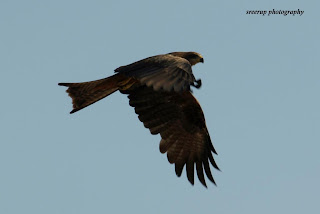 The White-bellied Sea-eagle (Haliaeetus leucogaster), also known as the White-bellied Fish-eagle or White-breasted Sea Eagle, is a large diurnal bird of prey in the family Accipitridae. It is closely related to other eagles, kites, hawks, harriers and vultures.
The White-bellied Sea-eagle (Haliaeetus leucogaster), also known as the White-bellied Fish-eagle or White-breasted Sea Eagle, is a large diurnal bird of prey in the family Accipitridae. It is closely related to other eagles, kites, hawks, harriers and vultures.It is resident from India through southeast Asia to Australia on coasts and major waterways. It is a distinctive bird. The adult has white head, breast, under-wing coverts and tail. The upper parts are grey and the black under-wing flight feathers contrast with the white coverts. The tail is short and wedge-shaped as in all Haliaeetus species.

The White-bellied Sea-eagle is one of the largest raptors in Southeast Asia, and the second largest bird of prey in Australia after the Wedge-tailed Eagle (Aquila audax) which stands up to 1 m.
The sea eagle is white on the head, rump and underparts and dark grey on the back and wings. In flight the black flight feathers on the wings are easily seen when the bird is viewed from below. The large, hooked bill is a lead blue-grey with a darker tip, and the eye is dark brown. The cere is also lead grey. The legs and feet are yellow or grey, with long black talons (claws).
 Young Sea-eagles in their first year are predominantly brown. Their plumage becomes more infiltrated with white until they acquire the complete adult plumage by their fourth or fifth year. The loud "goose-like" honking call is a familiar sound, particularly during the breeding season; pairs often honk in unison.
Young Sea-eagles in their first year are predominantly brown. Their plumage becomes more infiltrated with white until they acquire the complete adult plumage by their fourth or fifth year. The loud "goose-like" honking call is a familiar sound, particularly during the breeding season; pairs often honk in unison.Adult birds are unmistakable and unlikely to be confused with any other bird. Immature White-bellied Sea Eagles could be confused with Wedge-tailed Eagles. However the plumage of the latter is darker, the tail longer and the legs feathered.

They feed on fish and sea snakes, which they catch by skimming over the water and catching their prey with their talons. They do not dive under water, however. They keep within 1 km of shores, as there are no thermals over water.
The White-bellied Sea-eagle hunts mainly aquatic animals, such as fish, turtles and sea snakes, but it takes birds, such as Little Penguins, coots and shearwaters, and mammals as well. In the Bismarck Archipelago it has been reported feeding on various species of possum. It is a skilled hunter, and will attack prey up to the size of a swan. They also feed on carrion such as dead sheep, birds and fish along the waterline, and may even raid fishing nets. They harass smaller birds such as Swamp Harriers, forcing them to drop any food that they are carrying. Sea-eagles feed alone, in pairs or in family groups.
The White-bellied Sea-eagle hunts mainly aquatic animals, such as fish, turtles and sea snakes, but it takes birds, such as Little Penguins, coots and shearwaters, and mammals as well. In the Bismarck Archipelago it has been reported feeding on various species of possum. It is a skilled hunter, and will attack prey up to the size of a swan. They also feed on carrion such as dead sheep, birds and fish along the waterline, and may even raid fishing nets. They harass smaller birds such as Swamp Harriers, forcing them to drop any food that they are carrying. Sea-eagles feed alone, in pairs or in family groups.
My Experience:
This is for the first time i captured indian sea eagles in my camera. I first saw white bellied sea eagle catching fish on the way to port area in kakinada AP. Unfortunately i missed out that particular moment and timing to be capture in my camera. On 11th of August i was fortunate to capture some images of white bellied eagles which i am sharing to all my friends in the blog.
This is for the first time i captured indian sea eagles in my camera. I first saw white bellied sea eagle catching fish on the way to port area in kakinada AP. Unfortunately i missed out that particular moment and timing to be capture in my camera. On 11th of August i was fortunate to capture some images of white bellied eagles which i am sharing to all my friends in the blog.
Pictures of other sea eagles


About Kakinada (Andhra Pradesh, India)
Kakinada is a city and a municipal corporation in the Indian state of Andhra Pradesh. It is the largest city urban agglomeration and the headquarters of East Godavari district. It is fourth largest city in Andhra Pradesh. Kakinada Information Portal. This coastal city is witnessing rapid growth thanks to the recently granted Special Economic Zone status. The city also has a deep-water port which is expanding rapidly.
The presence of a small island called Hope Island about 5 km from Kakinada coast, makes Kakinada a natural Harbor. Prior to construction of the deep water port, the old anchorage port operated for several decades as the largest minor port in India. At present, both the deep water port and older anchorage port operate side by side. It is one of the busiest fishing center of east coast.
The presence of a small island called Hope Island about 5 km from Kakinada coast, makes Kakinada a natural Harbor. Prior to construction of the deep water port, the old anchorage port operated for several decades as the largest minor port in India. At present, both the deep water port and older anchorage port operate side by side. It is one of the busiest fishing center of east coast.
Reference: Wikipedia


